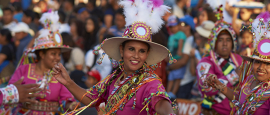Bolivia History, Language and Culture
History of Bolivia
Bolivia was initially inhabited by the ancient Aymara civilisation, which was concentrated in the western highlands. The Aymara were then conquered by the Incas, who were themselves conquered by the Spanish in 1538.
Throughout Bolivia’s colonial history, it was known as Upper Peru, where the population faced economic depression, exclusion from high-ranking jobs and regulations preventing trade with any countries other than Spain. This led to the Great Rebellion in 1780-82 by indigenous groups, which culminated in the Independence War in the early 1800s.
Despite being the first country in South America to declare war against the Spanish, it was the last to obtain independence: Venezuelan military leader, Simón Bolívar, secured a hard-earned victory in 1825 and was rewarded by having the new country named after him.
The Republic of Bolivia faced problems in its early years. War destroyed its infrastructure as well as the economy, and it was ruled by a succession of military dictators who tried, with mixed success, to unite the country's three disparate regions: the central region, the eastern Andes and the Altiplano.
Wars with three neighbouring countries followed, which led to its Pacific coast being taken by Chile. In 1953, Chile declared the port of Arica 'free' and since then, has allowed Bolivia certain privileges in its use. The issue was not fully settled until 1992, when Peru agreed to allow Bolivia free use of the port of Ilo for 100 years.
After an economic crisis, the Chaco War (the result of a border dispute with Paraguay) and a short rule under a military regime influenced by European fascism, Bolivia entered an era of political stability. Much of the credit is due to President Víctor Paz Estenssoro, who ruled between 1952-56, and 1960-64 and introduced universal suffrage and a national workers’ union.
He was elected again in 1985, at the head of a loose coalition of both left- and right-wing parties. By the time Paz Estenssoro ceded office to Jaime Paz Zamora in August 1989, rampant hyper-inflation had been dramatically cut. Both the ADN (Acción Democrática Nacionalista) and Zamora’s MIR (Movimiento de Izquierda Revolucionaria), sometimes in coalition, have enjoyed control of the presidency and the national assembly.
Leftist Evo Morales won a decisive victory in the presidential elections in 2005 against a backdrop of political turmoil and social unrest. Morales was inaugurated as Bolivia’s first-ever indigenous president in 2006, and he was re-elected in 2009.
Did you know?
• According to witchcraft beliefs a dried llama fetus should be buried in the foundations of new homes, to bring good luck.
• Silver mine city Potosi was once the richest city in the western hemisphere. Its streets were paved with silver and its horses wore silver horseshoes.
• The colourful Diablada Carnival of Oruro is based on Tiw, a devil-like deity who inhabits mines, lakes and rivers.




 You know where
You know where